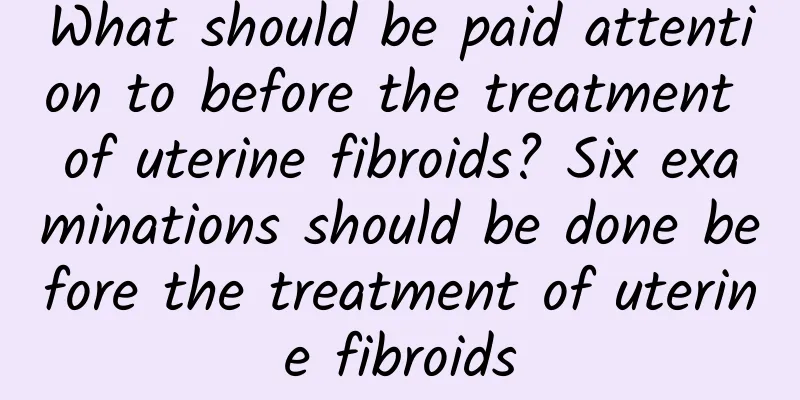What should be paid attention to before the treatment of uterine fibroids? Six examinations should be done before the treatment of uterine fibroids

|
For the examination items before the treatment of uterine fibroids, a detailed examination must be carried out before the treatment of uterine fibroids to determine the cause and location of the disease so as to treat it correctly and avoid misunderstandings. Let us take a look at the examination items before the treatment of uterine fibroids. 1. Ultrasound examination: Color B-ultrasound examination is more commonly used in clinical practice. It can show the enlargement of the uterus, irregular shape; the number, location, size of uterine fibroids, whether the uterine fibroids are uniform or liquefied cystic changes; and whether the surrounding areas are compressing other organs. It also helps to distinguish the degeneration or malignant changes of uterine fibroids, as well as the identification of ovarian tumors or other pelvic masses. 2. Detection of the uterine cavity: Use a probe to measure the uterine cavity. Intramural uterine fibroids or submucosal uterine fibroids often increase in size and deform. Therefore, the uterine probe can be used to detect the size and direction of the uterine cavity. Compared with the double clinic, it helps to determine the nature of the mass and understand whether there is a mass in the cavity and its location. 3. Plain X-ray: When uterine fibroids are calcified, they appear as scattered uniform spots, or a shell-like calcified capsule, or a rough, wavy, honeycomb-like shape. 4. Diagnostic curettage: Small submucosal uterine fibroids or dysfunctional uterine bleeding, endometrial polyps are not easy to be found through double diagnosis, and curettage can assist in diagnosis. If the suspected submucosal uterine fibroids are still unclear, hysterography can be used. 5. Hysterosalpingography: Ideal hysterosalpingography can not only show the number and size of submucosal uterine fibroids, but also locate them. Therefore, it is very helpful for the early diagnosis of submucosal uterine fibroids, and the method is simple. Photography of uterine fibroids shows whether the uterine cavity is full or not. 6. CT and MRI: These two examinations are generally not needed. The images of CT diagnosis of uterine fibroids only express details at a specific level, and the image structure does not overlap. The CT image of benign uterine tumors is enlarged in volume, uniform in structure, and high in density +40 to +60H (normal uterus is +40 to +50H). When diagnosing uterine fibroids, MRI has different signals for whether there is degeneration, type, and degree of degeneration inside the uterine fibroids. |
<<: How to treat uterine fibroids? What are the treatment measures for uterine fibroids?
Recommend
Detailed analysis of the symptoms of vaginitis
The symptoms of early vaginitis should be a commo...
Acupuncture points for treating pelvic inflammatory disease
Pelvic inflammatory disease refers to inflammatio...
Are uterine cysts and uterine fibroids the same?
Uterine cysts and uterine fibroids are different,...
What kind of examinations should women undergo before having an abortion?
Pregnant women who want to have an abortion need ...
Women must take precautions against pelvic inflammatory disease
Pelvic inflammatory disease is a common gynecolog...
Losing weight but can’t control your appetite? 5 ways to stop cravings and lose weight easily
Obesity is a health killer! Many people want to l...
Eating yogurt can enhance sexual performance! Beauty Research: Vanilla Flavor is the Best Choice
Are you still superstitious about folk remedies o...
What are the causes of ectopic pregnancy?
Ectopic pregnancy is a common gynecological disea...
Five common causes of menstrual cramps
Dysmenorrhea can seriously affect people's no...
What are the dangers of abortion pills? There are 6 major dangers
The hazards of abortion pills include incomplete ...
Can I get pregnant successfully with an enlarged cervix?
Cervical hypertrophy usually does not directly le...
If you want to lose weight, don't get fat. Eat half an hour after exercise.
Error 2. Eat immediately after exercise Athletes ...
How to deal with habitual miscarriage?
For patients with habitual miscarriage, if they w...
Discuss in detail with experts about some of the dangers of vaginitis
The symptoms of each patient with vaginitis are d...
What are the symptoms of functional uterine bleeding?
The main symptoms of functional uterine bleeding ...









